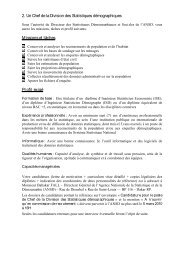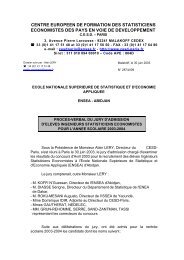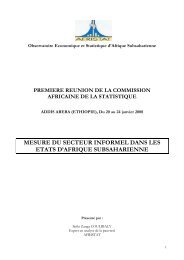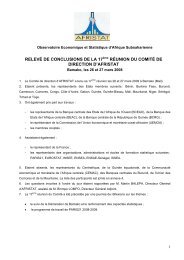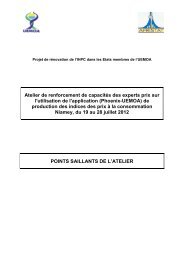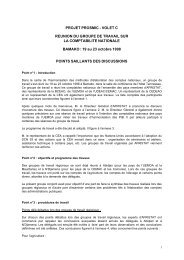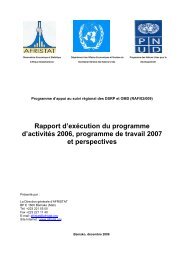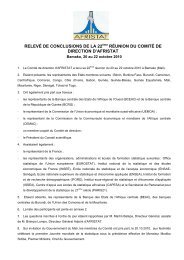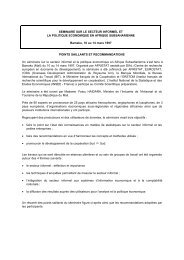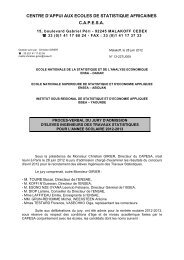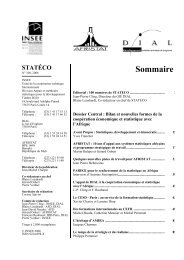Global Purchasing Power Parities and Real Expenditures - Afristat
Global Purchasing Power Parities and Real Expenditures - Afristat
Global Purchasing Power Parities and Real Expenditures - Afristat
Create successful ePaper yourself
Turn your PDF publications into a flip-book with our unique Google optimized e-Paper software.
204 <strong>Global</strong> <strong>Purchasing</strong> <strong>Power</strong> <strong>Parities</strong> <strong>and</strong> <strong>Real</strong> <strong>Expenditures</strong>EKS method (Éltetö-Köves-Szulc method). The methodused to aggregate basic-heading PPPs to obtain PPPs foreach level of aggregation up to <strong>and</strong> including GDP. Strictlyspeaking, the EKS method is a procedure whereby anyset of intransitive binary index numbers are made transitive.The procedure is independent of the method usedto calculate the basic-heading intransitive binary indexes.The method used to obtain the intransitive binary PPPsfor a basic heading or aggregate involves calculating first amatrix of Laspeyres-type PPPs, then a matrix of PaaschetypePPPs, <strong>and</strong> finally, by taking the geometric mean of thetwo, a matrix of Fisher-type PPPs. The Fisher-type PPPsare made transitive <strong>and</strong> multilateral by applying the EKSprocedure, which involves replacing the Fisher-type PPPbetween each pair of countries by the geometric mean ofitself squared <strong>and</strong> all the corresponding indirect Fisher-typePPPs between the pair obtained using the other countriesas bridges. The resulting EKS PPPs provide real final expendituresthat are not additive nor subject to the Gerschenkroneffect. EKS results are considered to be better suited tocomparisons across countries of the price <strong>and</strong> volume levelsof individual aggregates.Error. The difference between the observed value of a PPPor volume index <strong>and</strong> its “true” value. Errors may be r<strong>and</strong>omor systematic. R<strong>and</strong>om errors are generally referred to as“errors.” Systematic errors are called “biases.”Expenditure categories. The level of aggregation betweenmain aggregates <strong>and</strong> expenditure groups.Expenditure weights. The shares of expenditure componentsin current-price GDP.Exports of goods <strong>and</strong> services. The value (f.o.b.) of exportsof goods <strong>and</strong> services.Final consumption consists of goods <strong>and</strong> services used upby individual households or the community to satisfy theirindividual or collective needs or wants.Final expenditure consists of final consumption expenditure<strong>and</strong> gross fixed capital formation.Fisher-type PPP. The PPP for a basic heading or an aggregatebetween two countries that is defined as the geometricmean of the Laspeyres-type PPP <strong>and</strong> the Paasche-type PPPfor the basic heading or the aggregate. See also “LaspeyrestypePPP” <strong>and</strong> “Paasche-type PPP,” because their formulationdepends on whether they are being used to calculatebasic-heading PPPs or to aggregate basic-heading PPPs.Fixity. The convention whereby the price <strong>and</strong> volumerelativities between a group of countries that were establishedin a comparison covering just that group of countriesremain unchanged, or fixed, when the countries of thegroup are included in comparisons with a wider group ofcountries. For example, the price <strong>and</strong> volume relativities ofthe ICP regions <strong>and</strong> Eurostat-OECD remain unchanged inthe global comparison.Food <strong>and</strong> nonalcoholic beverages. Food products <strong>and</strong> nonalcoholicbeverages purchased for consumption at home.Excluded are food products <strong>and</strong> beverages sold for immediateconsumption away from the home by hotels, restaurants,cafés, bars, kiosks, street vendors, automatic vendingmachines, <strong>and</strong> so forth; cooked dishes prepared by restaurantsfor consumption off their premises; cooked dishesprepared by catering contractors, whether collected by thecustomer or delivered to the customer’s home; <strong>and</strong> productssold specifically as pet foods.Furnishings, household equipment, <strong>and</strong> household maintenance.Includes expenditures on furniture <strong>and</strong> furnishings;carpets <strong>and</strong> other floor coverings; household textiles;household appliances; glassware, tableware, <strong>and</strong> householdutensils; tools <strong>and</strong> equipment for house <strong>and</strong> garden; <strong>and</strong>goods <strong>and</strong> services for routine household maintenance.GDP. Gross domestic product, expenditure-based, is totalfinal expenditures at purchasers’ prices, including the f.o.b.value of exports of goods <strong>and</strong> services, less the f.o.b. valueof imports of goods <strong>and</strong> services.General government. The institutional sector that consistsof central, regional, state, <strong>and</strong> local government units,together with social security funds imposed <strong>and</strong> controlledby those units. It includes nonprofit institutions engaged



